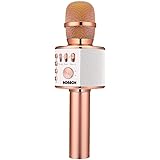Ninja CREAMi, Ice Cream Maker, Ice Cream, Gelato, Sorbet ,Milkshakes, Mix-ins, Smoothie Bowls & More, 7-in-1, Ice Cream Pints, Pint lid, Healthy Ice Cream, Compact, Perfect for Kids, Black, NC299AMZ
$168.49 (as of November 20, 2024 21:24 GMT +00:00 - More infoProduct prices and availability are accurate as of the date/time indicated and are subject to change. Any price and availability information displayed on [relevant Amazon Site(s), as applicable] at the time of purchase will apply to the purchase of this product.)JBL Vibe Beam - True Wireless JBL Deep Bass Sound Earbuds, Bluetooth 5.2, Water & Dust Resistant, Hands-free call with VoiceAware, Up to 32 hours of battery life (Black)
$39.95 (as of November 21, 2024 21:28 GMT +00:00 - More infoProduct prices and availability are accurate as of the date/time indicated and are subject to change. Any price and availability information displayed on [relevant Amazon Site(s), as applicable] at the time of purchase will apply to the purchase of this product.)Apple AirTag 4 Pack
$72.26 (as of November 20, 2024 21:24 GMT +00:00 - More infoProduct prices and availability are accurate as of the date/time indicated and are subject to change. Any price and availability information displayed on [relevant Amazon Site(s), as applicable] at the time of purchase will apply to the purchase of this product.)Amazon Basics Adjustable Guitar Folding A-Shape Frame Stand for Acoustic and Electric Guitars with Non-Slip Rubber and Soft Foam Arms, Fully Assembled, Black
$13.99 (as of November 21, 2024 21:28 GMT +00:00 - More infoProduct prices and availability are accurate as of the date/time indicated and are subject to change. Any price and availability information displayed on [relevant Amazon Site(s), as applicable] at the time of purchase will apply to the purchase of this product.)Stanley Quencher H2.0 Tumbler with Straw 14 oz | Twist On 3-Way Lid | Cupholder Compatible for Travel | Insulated Stainless Steel Cup | BPA-Free | Ash
$20.00 (as of November 20, 2024 21:24 GMT +00:00 - More infoProduct prices and availability are accurate as of the date/time indicated and are subject to change. Any price and availability information displayed on [relevant Amazon Site(s), as applicable] at the time of purchase will apply to the purchase of this product.)When it comes to kitchenware, a well-designed lid can make all the difference in cooking performance, convenience, and safety. From stainless steel to silicone, lids come in a wide range of materials, each with its own unique characteristics, advantages, and disadvantages. In this exhaustive guide, we will delve into the world of lids, exploring their various types, features, and performance.
Material Comparison
- Stainless Steel Lids
- Pros: Durable, resistant to scratches and corrosion, non-reactive, easy to clean
- Cons: Can be heavy, may retain heat, can be noisy when stacked
- Popular Brands: All-Clad, Calphalon, KitchenAid
- Silicone Lids
- Pros: Lightweight, flexible, easy to store, resistant to high temperatures
- Cons: May not provide a tight seal, prone to scratches and cracks
- Popular Brands: Silpat, OXO, Cuisinart
- Glass Lids
- Pros: Non-reactive, easy to clean, visible cooking progress
- Cons: May shatter or break if dropped, can be heavy
- Popular Brands: Pyrex, Anchor Hocking, Corning
- Hard Anodized Lids
- Pros: Durable, non-stick coating, resistant to scratches and corrosion
- Cons: May chip or flake off over time, can be noisy when stacked
- Popular Brands: Calphalon, All-Clad, T-fal
- Ceramic Lids
- Pros: Non-reactive, easy to clean, resistant to scratches and corrosion
- Cons: May chip or crack if dropped, can be heavy
- Popular Brands: Le Creuset, Emile Henry, Staub
Design Features
- Steam Venting: Some lids feature steam vents that allow for controlled release of steam during cooking.
- Lid Locks: Secure-fitting lids with locks or clasps ensure a tight seal and prevent accidental lid removal.
- Handle Design: Ergonomic handles make it easier to lift and maneuver the lid, reducing strain on the user’s hand.
- Material Combinations: Some lids feature combined materials, such as stainless steel and silicone, offering the benefits of both.
Performance Analysis
The performance of a lid depends on several factors, including material, design features, and cooking technique. In general, stainless steel and hard anodized lids provide excellent heat retention and distribution, while silicone lids are ideal for low-temperature cooking and storage.
When choosing a lid, consider the type of cookware you use most frequently, your personal preferences regarding material and design features, and the specific cooking tasks you need to accomplish. By understanding the characteristics and advantages of different types of lids, you can make an informed decision that meets your kitchen needs and enhances your cooking experience.
Recommendation
For users seeking a versatile and durable lid solution, we recommend stainless steel or hard anodized lids from reputable brands like All-Clad or Calphalon. For those prioritizing ease of storage and flexibility, silicone lids may be the better choice.
Rating: 4.5/5
Price Range: $10-$50 (per lid)
Availability: Widely available online and in-store at major retailers









